Not all mobile app categories can boast a high retention rate on day 30. Health and fitness applications, in particular, struggle with long-term user retention, with an average 30-day retention rate of only 7.88%. Plus, out of 10 consumers who use fitness and general wellness apps, only six do so daily. What about the rest? Well, they download your app, give it a whirl… and fall by the wayside without forming a habit of using it regularly.
But how can your fitness or wellness app buck this trend? Think effective, data-driven user retention and engagement techniques. These will help your mobile app achieve and retain high-touch interaction with new and existing users — and stay consistently on their radar.
The Orangesoft team has analyzed 58 most downloaded fitness apps and curated the most effective mobile app user retention strategies that these applications implement to become habit-forming.
Personalized user experience
Personalization is hands-down the most effective way to form a bond with mobile users and cut through the noise of generic, look-alike workout and wellness experiences. For fitness applications, personalization is more than just a way to make the user feel valued. It’s a matter of effectiveness.
While the majority of fitness applications reviewed offer personalized workout plans, nutrition plans, and adaptable coaching features, these capabilities are often basic and lack real-time adaptability. For example, in MyFitnessPal and Fitbit apps, personalized coaching features are static and incapable of adjusting to users’ varying schedules, daily routines, preferences, and poses in real time.
To dynamically adjust to users’ evolving needs and preferences, the personalization engine within fitness apps requires self-learning capabilities, real-time adaptability, and/or context-aware customization.
Here’s how fitness apps can potentially leverage these capabilities to promote long-term user engagement:
| Self-learning capabilities | Real-time adaptability | Context-aware customization | |
|---|---|---|---|
| Definition | The application autonomously improves over time based on user-specific data. | The app responds to immediate user input, adjusting the workout during the session, not after it. | The app leverages contextual cues such as location, time of day, and past workout history to fine-tune the workout recommendations and experience. |
| Potential implementation | At the onset, the app offers generic cardio workouts. As the app analyzes more user data, the app tailors recommendations to the user's current fitness level. It progresses users to more challenging training and prioritizes workout types the user is more likely to complete. | During the workout, the user starts experiencing shoulder pain. The user tells the app, "I have shoulder pain." The app modifies the remaining exercises in real-time based on the user’s input. | Based on the analyzed data, the app recognizes that the user prefers short, energy-boosting workouts in the morning. The app adjusts to the user’s preferences and starts suggesting quick 20-minute HIIT routines in the morning. |
| Tech enablers | Machine learning, generative AI, and more. | Wearables, adaptive AI, generative AI, pose estimation, and more. | Varies based on the specific customization. |
Featured examples
In 2024, Peloton, a popular connected fitness platform with on-demand and live workout classes, launched personalized workout plans that offer users weekly workout suggestions customized to their fitness goals, favorite activities, workout frequency, and other preferences. The app uses previous workout history to determine the member’s favorite instructors, music preferences, and class selections to generate a custom weekly schedule.
The suggestions are flexible, too, allowing users to take them in any order they want each week.
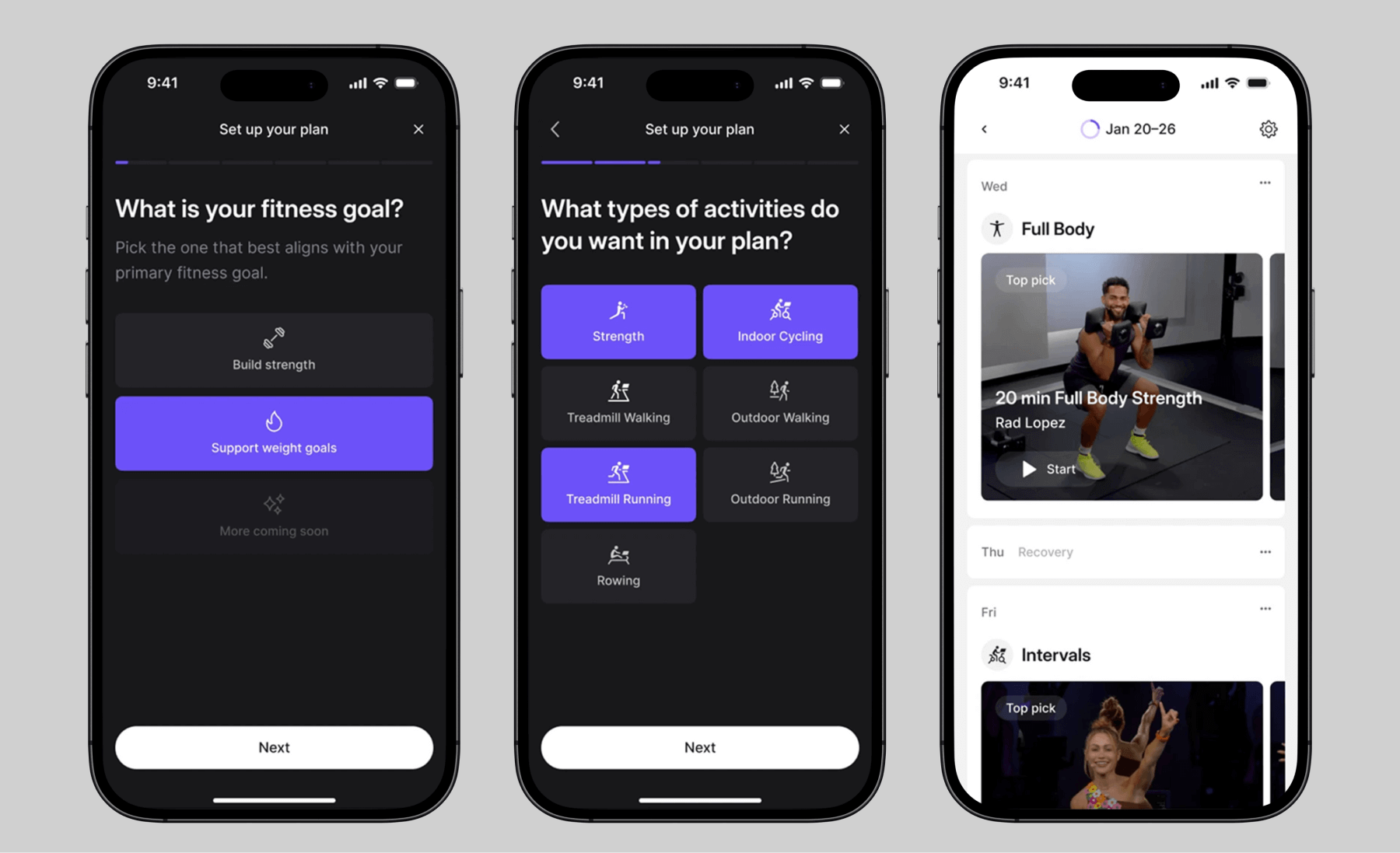
With over 4 million downloads, Gymstreak is a workout app that stands out for its use of advanced technology. The app serves personalized workout routines that adjust in real time based on users’ performance. Gymstreak also monitors the user’s every workout, meal, and recovery period to uncover valuable insights and ensure its guidance is data-driven, thus delivering great results for users.
In 2024, the app was kitted out with Gymstreak AI, a workout generator powered by generative AI. Users can simply tell the app what kind of workout they’re looking for and get a perfect routine tailored to their unique goals, fitness level, equipment, and profile — in a few minutes.
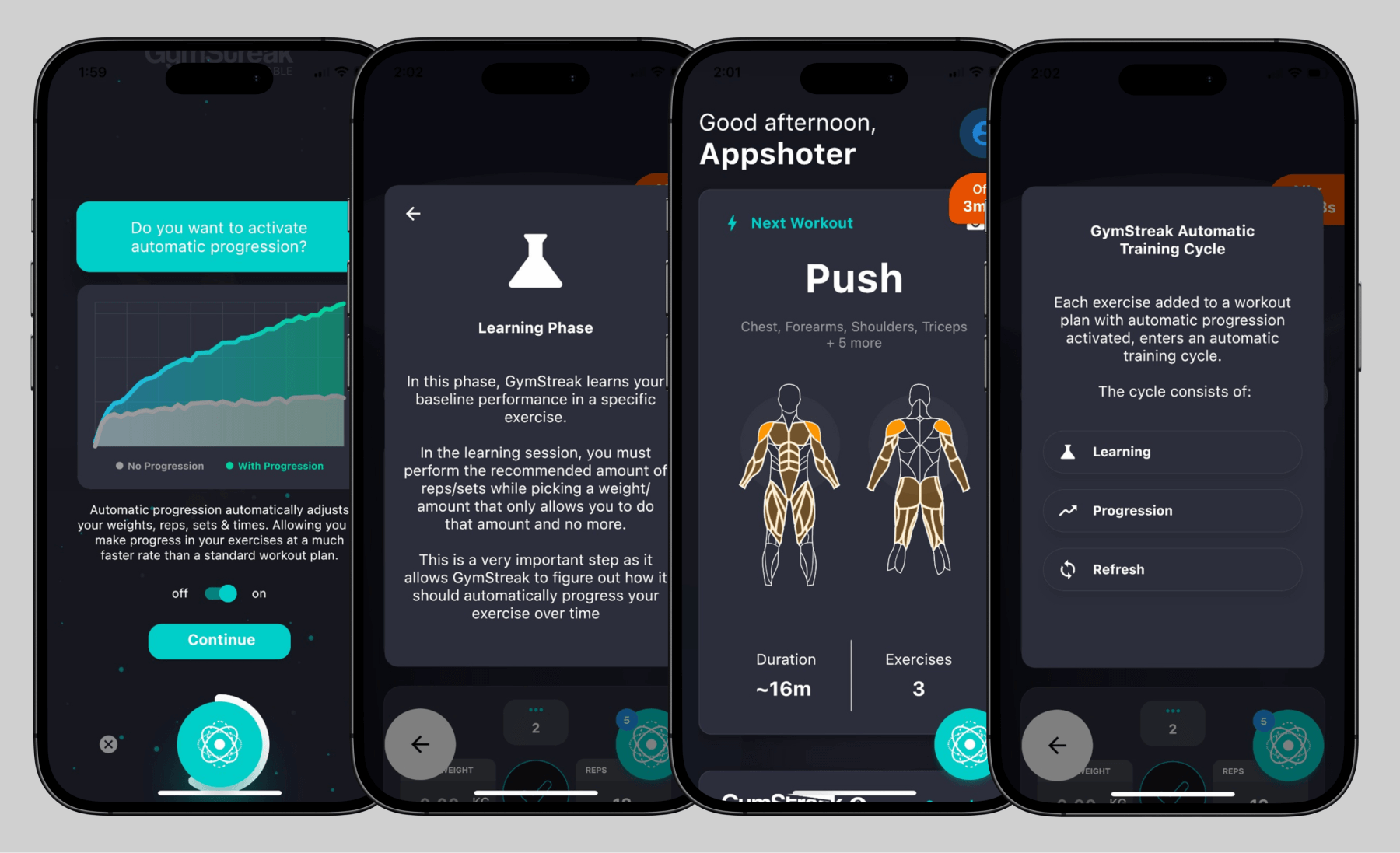
Goal setting and feedback
For fitness enthusiasts, goals are like road maps — they guide the journey and keep users focused on their fitness destination. More importantly, goals increase users' physical activity levels, thus increasing the time users spend in your app. Feedback mechanisms like progress tracking can further nudge users toward their fitness goals and encourage them to continue using your app.
But just letting users set a static goal won’t cut it if you want users glued to their smartphones. While most physical activity apps leverage the standard approach of enabling users to outline initial goals, they typically don’t provide much feedback on whether those goals are realistic or achievable — which can negatively impact users’ motivation and behavior later on.
Here are the non-trivial techniques you can use to boost user engagement through more holistic goal-setting:
- Enabling users to set goal difficulty and break down goals into smaller, actionable steps.
- Allowing users to set and adjust goals based on their current fitness level, progress, and evolving aspirations.
- Automatically re-evaluating goals based on users’ achievements and failures — and suggesting modifications to maintain optimal challenge and motivation.
Providing detailed real-time and post-workout feedback on users’ progress, including form analysis, intensity level, metrics, improvements, and suggestions for improvement in various forms (visual cues, audio prompts, or detailed analytics).
Featured examples
WHOOP is a health and fitness company that offers a wearable device designed to monitor various aspects of your wellbeing, including sleep, strain, recovery, stress, and other health metrics. The device operates without a screen, meaning all data is accessed through the WHOOP mobile app. Flexible goal-setting is among those things that differentiate WHOOP from other similar apps. Along with preset plans for common goals, the app allows users to set unique goals based on their 30-day baselines, coaching them toward the personalized improvements they want to make.
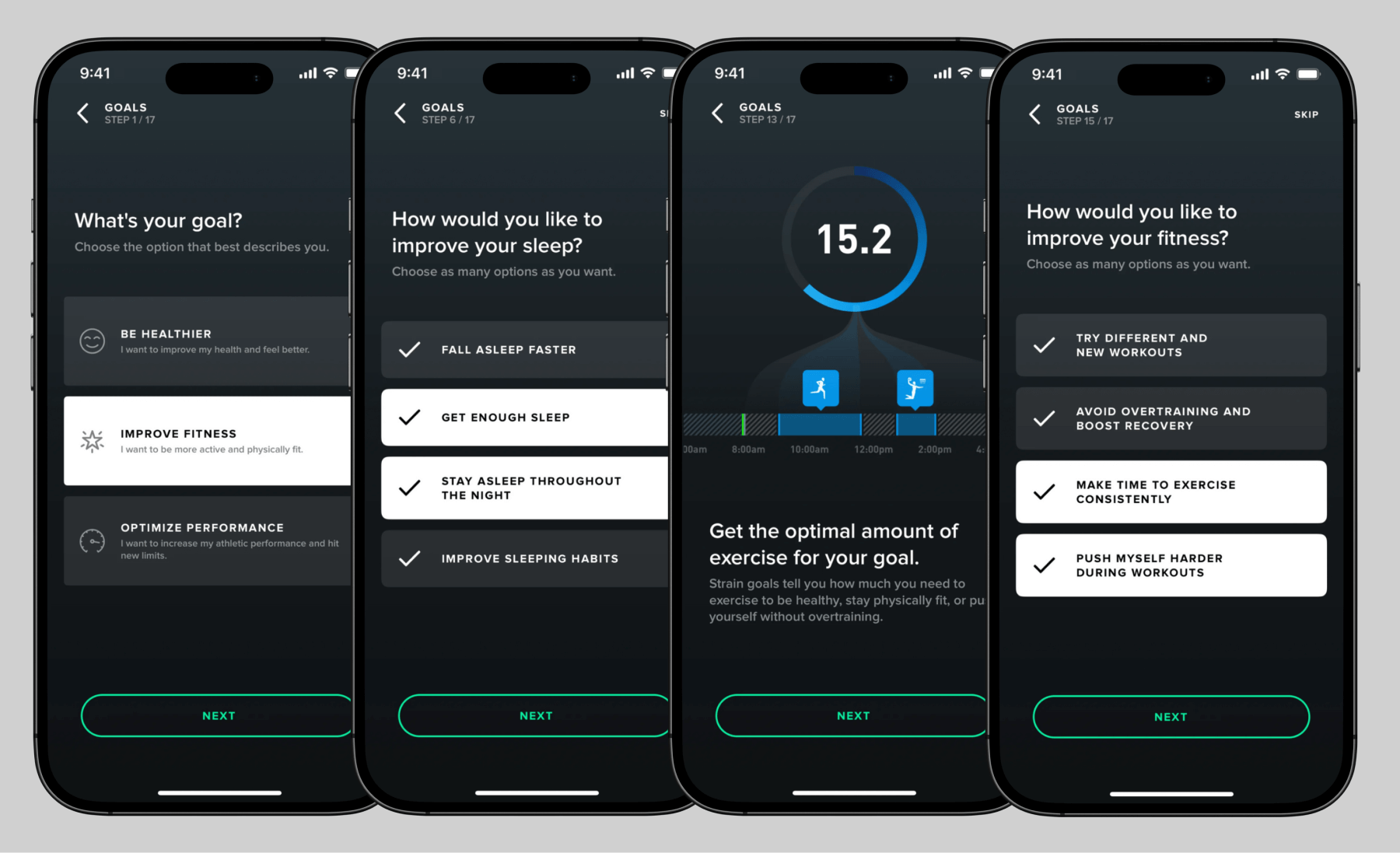
With Google Fit, users can bring their health and activity stats under one roof by blending data from multiple apps and devices. However, Google Fit is not just a set of pretty graphs and charts that record what users eat and. It’s a full-fledged virtual coach that puts users on a path to a healthier and more active life.
After setting their activity goals, users earn Heart Points, an activity goal developed by Google Fit in partnership with the American Heart Association. The more heart-pumping the activity is, the more Heart Points users are awarded. And because Google Fit can team up with other fitness solutions, it makes sure each activity, whether it’s walking the dog, swimming, or pilates, is jotted down and translated into Heart Points.
Users who consistently hit their weekly and daily goals can easily adjust them to stay challenged and maintain a healthy lifestyle.
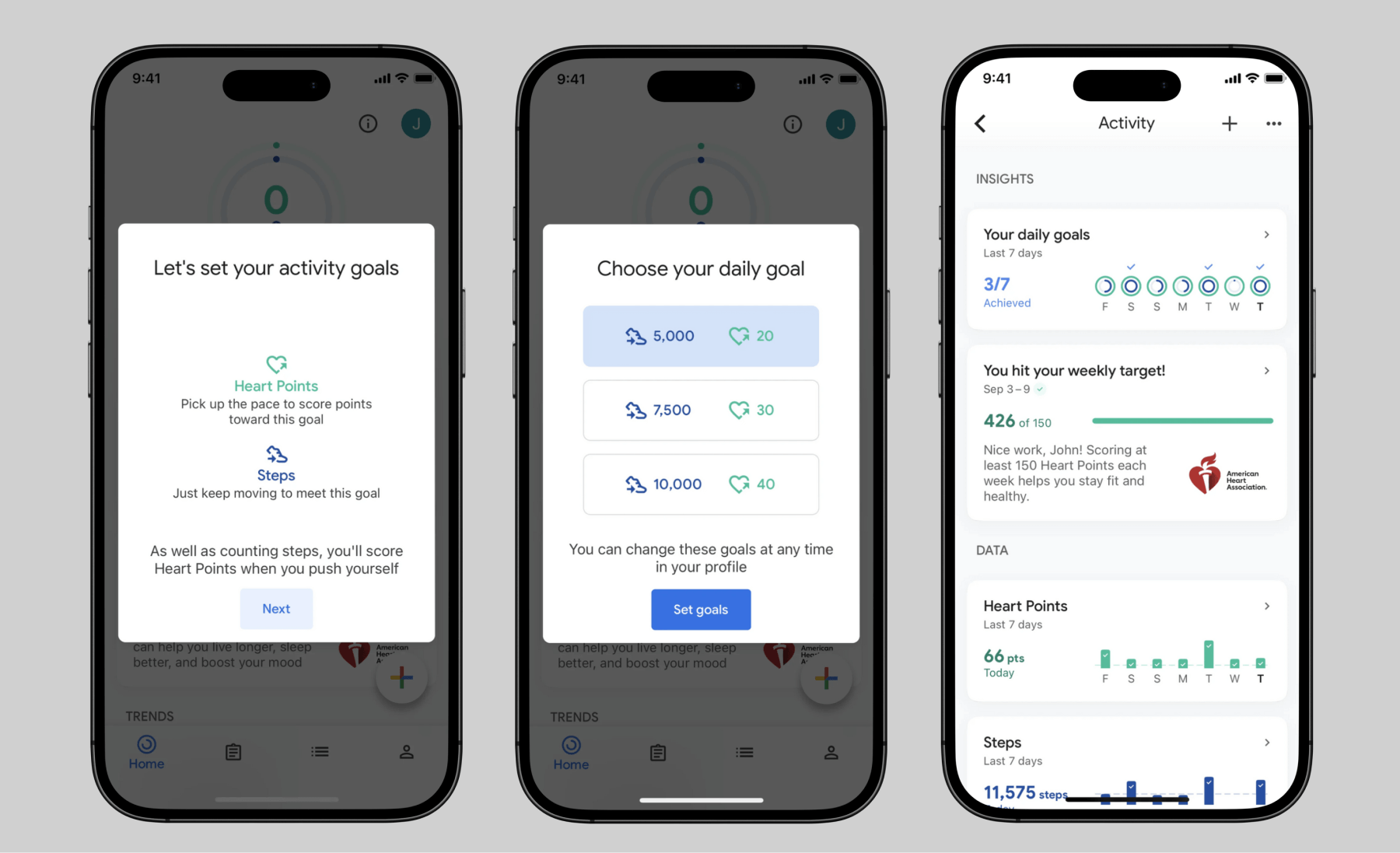
Habit-forming features
The easiest way to help users make a habit of using your fitness app? Try incorporating habit-forming features. While personalized reminders, badges, and leaderboards can each contribute to making your app more engaging, you can combine them to hit the sweet spot and tap into the ‘hook model.’
The ‘hook model’ consists of the four key components to make habits stick:
- Trigger — the app reels in the user by sending a personalized notification or a reminder.
- Action — once the user is hooked by the cue, the app offers a quick and easy challenge, such as a 5-minute workout, to help them gradually build a routine.
- Reward — after the user completes the challenge, the app provides instant gratification through a badge, streak, or an encouraging message.
- Investment — users can share their fitness achievements on social media or compete with friends. The fourth element promotes a sense of investment and accountability, motivating users to build longer streaks because they feel they’ve already made progress.
Featured examples
Do you know how most fitness apps are all "push your limits and never take a rest day, or else your weeklong streak will be ruined"? Few things can be more disheartening to fitness rookies than this spiel. Gentler Streak, a workout fitness tracker, has a gentler narrative that sees breaks and failures as a part of the user’s eventual success.
Each day, the app gives users a nudge — a daily workout action that ranges from rest to intense workouts based on their level of readiness. The app recognizes small wins and provides a positive reinforcement loop, thus becoming a part of users’ daily routines.
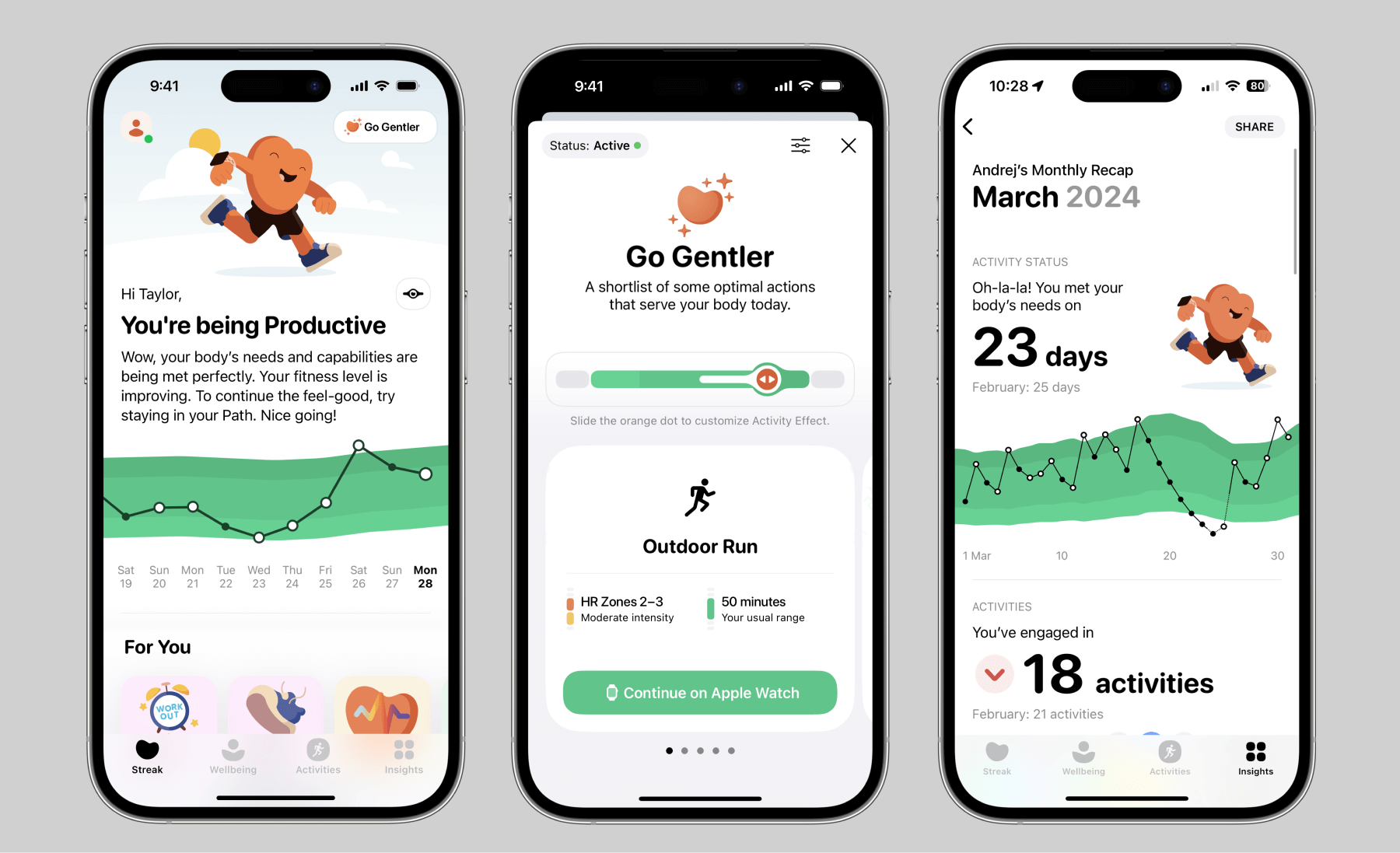
Consistency in your fitness routine creates a habit, and that habit paves the way for lasting fitness success. But only a few of us have the time for regular workouts. The Seven app, with its short, science-backed 7-minute workouts, has emerged to address this problem, helping users create a habit of training.
Each workout is presented as a daily challenge that brings the user closer to their overarching fitness goals.
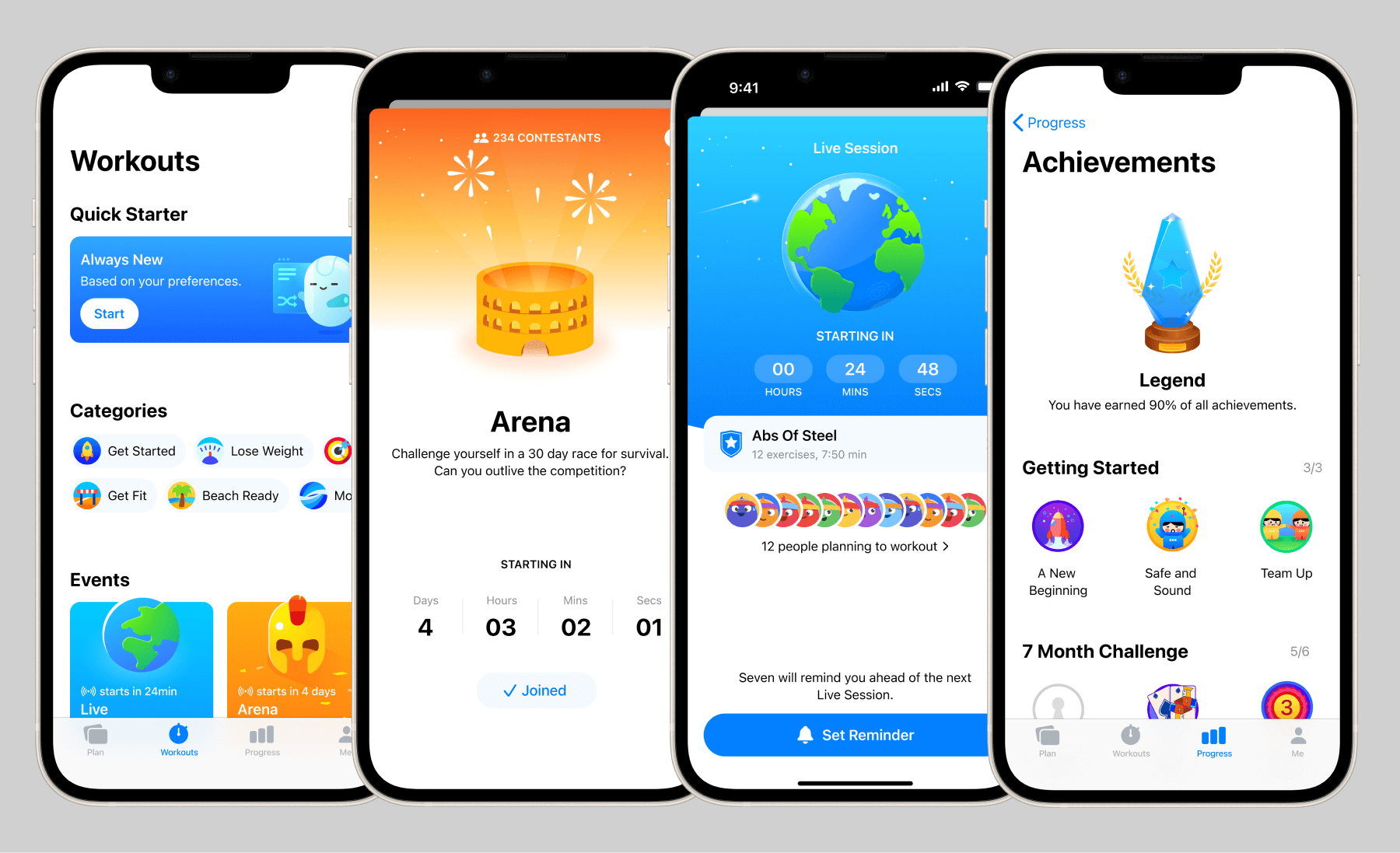
Gamification
Did you know that most Americans spend 1 to 5 hours per week playing video games? Now, imagine the impact on your retention rates if you make your fitness app as fun and challenging as a game. Gamification of fitness has long become a best practice integrated into the majority of physical activity applications.
In apps, it can manifest as structural gamification, which adds gamified elements to the app without changing its core content. Structural gamified elements can include points, badges, leaderboards, and progress bars.
Then there’s also content gamification that transforms content itself into a game-like experience. In fitness apps, it usually takes the form of:
- Quests and challenges — time-limited challenges, such as a 30-day workout challenge or a step challenge.
- Storytelling — game-like fitness experiences where users can either turn their workouts into a gripping story or unlock narrative-driven content as they progress.
- Interactive workouts — interactive video games that require physical movement.
You can combine the two types of gamification to encourage interaction with the app. If your fitness app incorporates structural gamification only, make sure to include varying levels of challenges paired with personalized and adaptive gamification methods based on individual user motivations to keep all users engaged.
💡Tip: When analyzing popular fitness apps, our team discovered that only a scarce few used behavioral economics principles in gamification. This means that there’s an untapped opportunity for apps that amplify gamified elements with loss aversion, social proof, random awards, and default options.
Featured examples
Strava, a social network app for athletes, uses gamification to increase user engagement and expand the ways users can interact with it. From individual challenges to challenges with group goals, Strava likes to keep users on their feet and add a competitive edge to fitness routines. Some group challenges in the app also have a leaderboard that ranks contenders.
Aiming to increase users’ activity levels, the app highlights popular routes, generates power curves to benchmark users’ activity patterns, and allows users to share their weekly heatmaps with peers. Strava also has a badge reward system, progress bars, and a signature social feed, all transforming fitness into an exciting adventure.
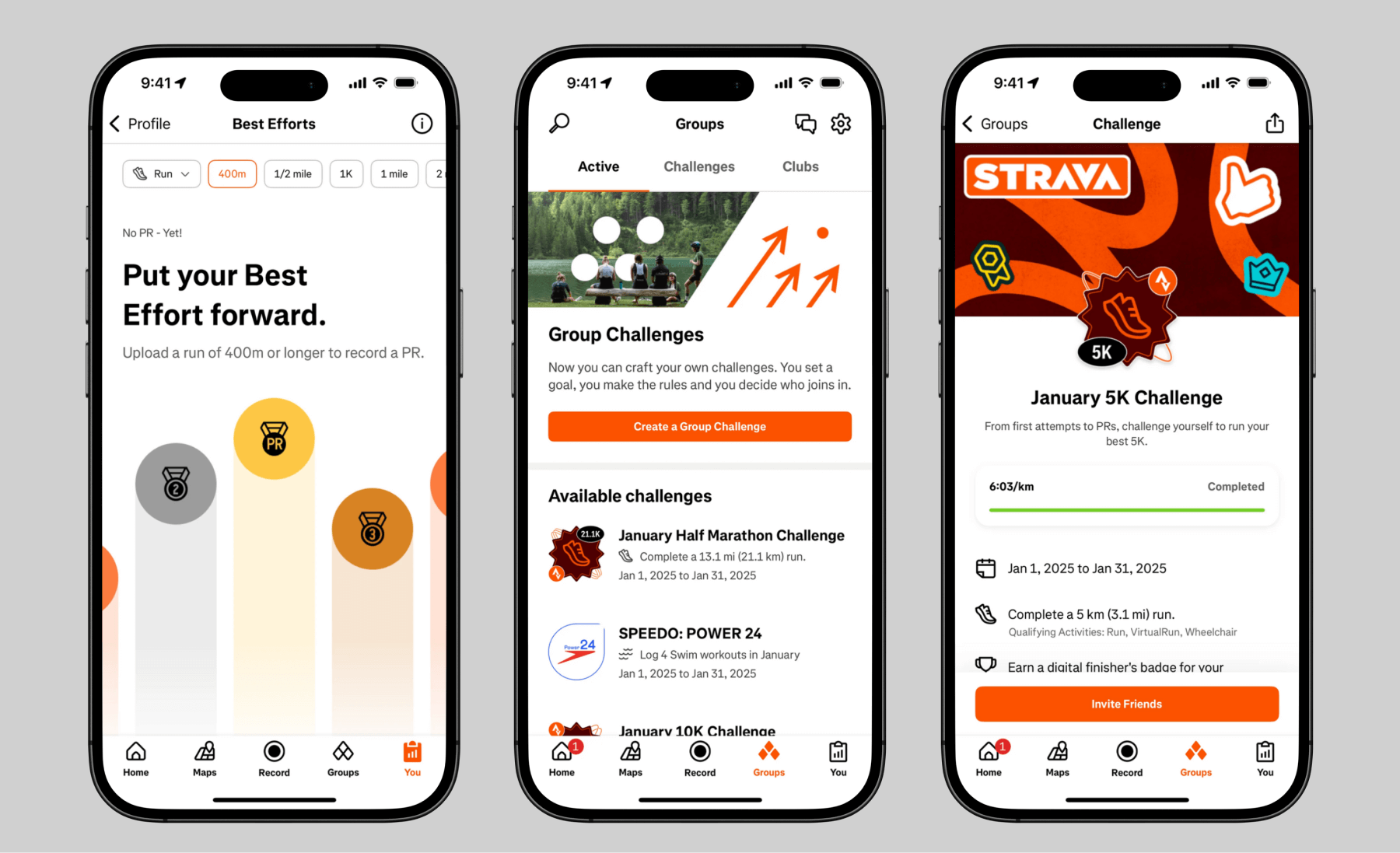
Brimming with over 100 daily workouts, the Alive app is a fitness platform by Whitney Simmons that keeps users coming back for more by gamifying wellbeing. Putting mental and physical wellbeing over everything else, the Alive app pairs its regimens with daily inspiration, wellness reminders, and gratitude prompts that turn self-care into a quest.
The Alive app revolves around the idea that we don’t simply transition into a healthy lifestyle overnight. Wellbeing is more of a journey, with each workout, challenge, and rest day contributing to our progress. That’s why the app portrays users’ progress as a journey, with weight tracking, photos, and a comprehensive progress timeline.
The Alive app also offers a 30-day challenge format that combines daily mindful mobility, workouts, and journal prompts. By framing the wellness experience as a challenge with daily tasks, incorporating classic gamified elements like badges, and keeping a balance between physical and mental wellbeing, the Alive app encourages users to stick with their healthy habits — and with the app.
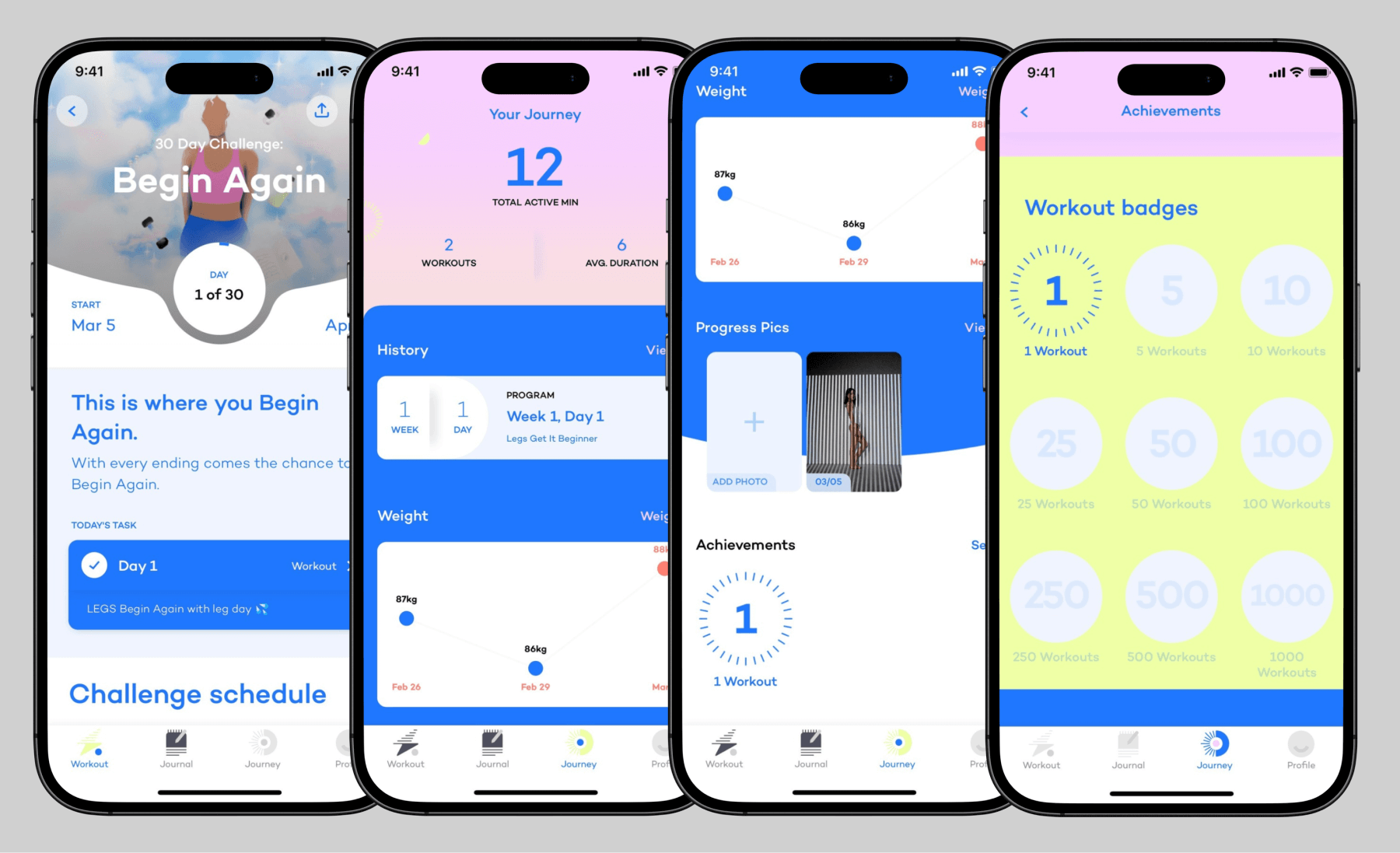
Social features and community support
We are all, by nature, social animals. Fitness apps can build on the inherently social nature of humans to maximize user participation and foster a sense of community.
A supportive community, positive peer pressure, and a social identity can make all the difference when it comes to keeping users engaged — and here’s how you can harness the social dynamics in your app:
- Build a virtual fitness community — allow users to connect with friends, send friend invites, share progress, and participate in community challenges.
- Incorporate social features — implement social feeds, groups, in-app chats, and leaderboards to encourage social sharing and peer support.
- Launch live workout classes — offer live workout classes with real-time interaction and feedback from instructors and other participants.
- Highlight personal identity in user profiles — allow users to put their fitness adventures and accomplishments out there.
Many leading fitness platforms use social and community features but fail to personalize them to users’ unique behaviors, needs, and preferences.
Adaptive, AI-powered social interactions can help the app establish a deeper connection with the user and suggest relevant social groups, challenges, and events.
Featured examples
Any Distance is a fitness social network that gamifies movement and allows users to track and share over 90+ activities. Designed to promote camaraderie among users, this app creates a supportive, personalized social network limited to 100 close friends, also known as Any Distance Active Clubs. Unlike social media apps, this feature allows users to choose which fitness stats to share with friends.
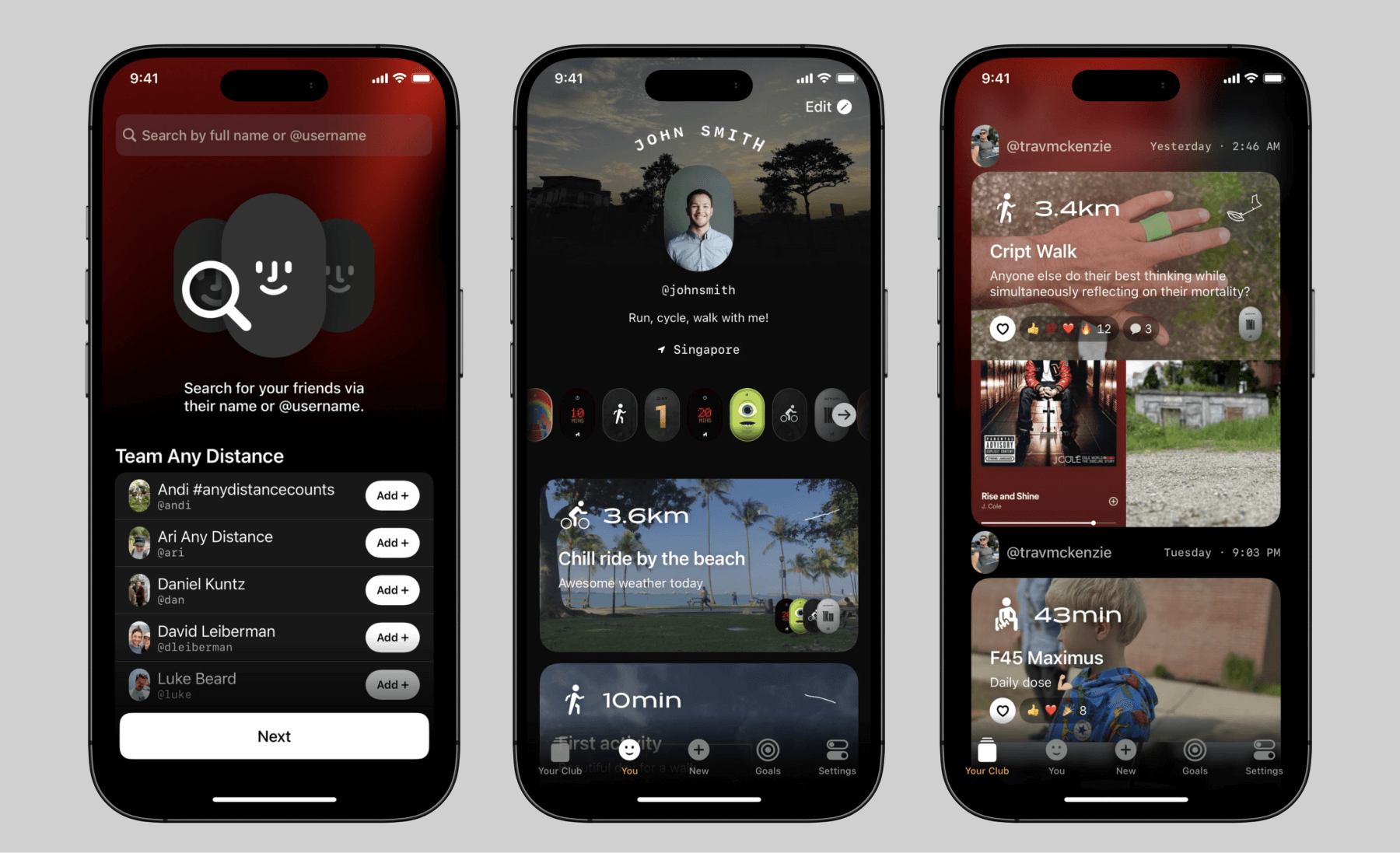
Hevy is a free gym workout tracker and planner app that allows athletes to log their workouts and keep tabs on their fitness progress. The app banks on various social features to keep users accountable while also turning solo gym sessions into a shared experience. Users can follow other athletes, share routines, post gym selfies and training footage, and stack up their performance against others.
What’s interesting about Hevy is that users don’t just get a glimpse of other athletes’ routines. They can zoom in on their routines—the number and type of sets, reps, exercise notes, and other details— and save the ones they like to their profiles If a member has a private profile, users need to send a follow request to access all the information, much like on other social media networks.
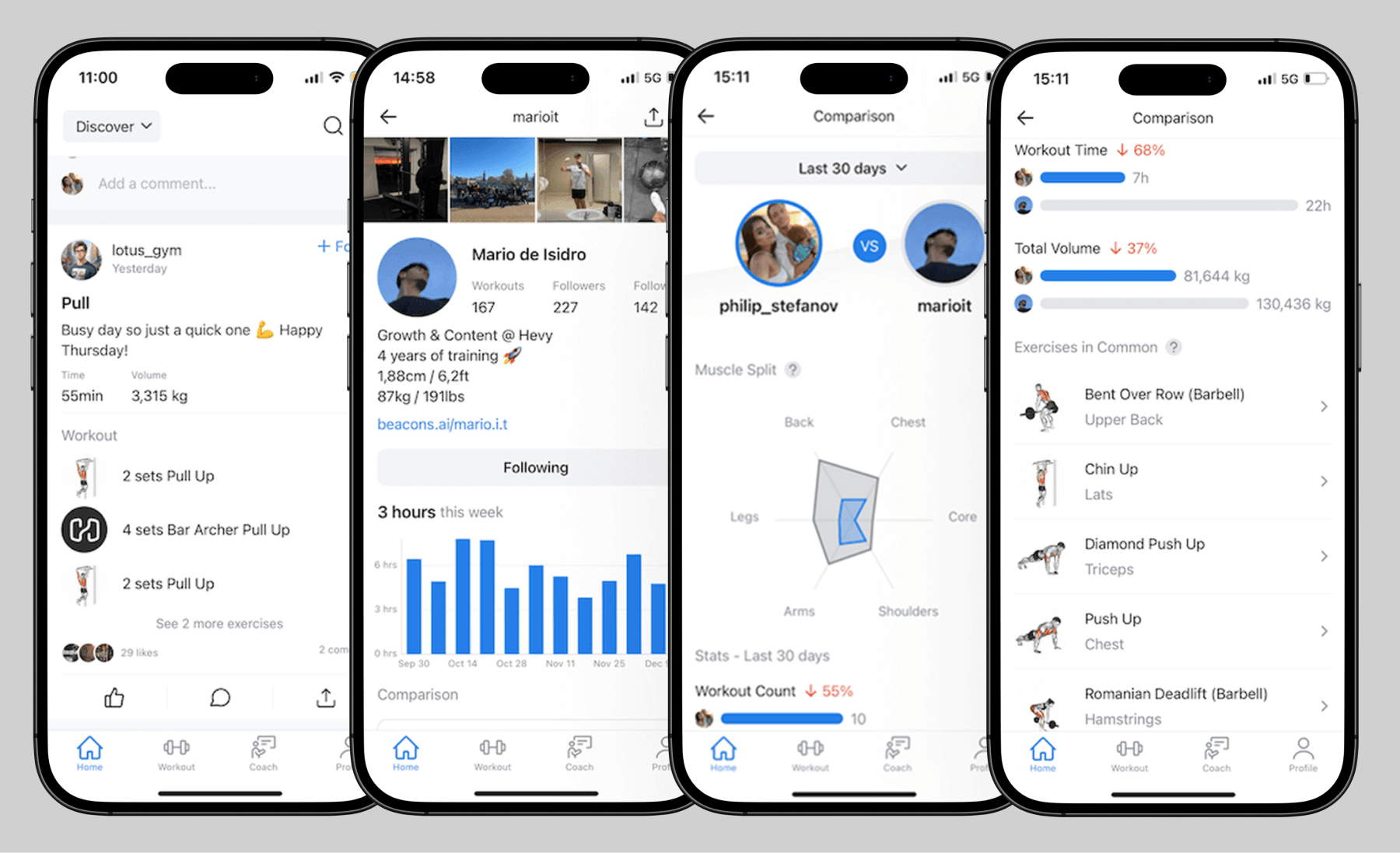
Hyper-personalized onboarding process
If you want newly acquired users to fall in love with your app right out of the gate, your app has to show up for them as early as the onboarding process. Along with being as straightforward and concise as it gets, the onboarding process should also check the following boxes:
- Leverage data (age, gender, fitness level, goals) obtained during sign-up to create a personalized onboarding journey.
- Automatically sync data from Apple Health, Google Health, and wearable devices to provide tailored fitness advice.
- Offer specific workout plans, challenges, or tutorials based on user preferences.
- Include interactive tutorials (demos, gamified tutorials) to walk users through the core app features.
- Dynamically adjust questionnaires based on user responses to ensure an engaging onboarding experience.
As your interaction with users unfolds, it’s important not to overload them with initial onboarding screens and questions. Seven to eight screens are enough to gather background data on the user’s fitness level, available equipment, core fitness goals, and other information.
You can use progressive registration to ask for information gradually, without lengthy forms during the initial sign-up process, and integrate subtle tutorial formats like overlays for contextual in-app guidance.
Featured examples
Fitbod’s onboarding flow is a great example of how the application can make the most out of the first interaction — without bombarding the user with a thousand irrelevant questions. The onboarding process kicks off with a motivational message and continues by asking meaningful questions about the user’s underlying motivation, fitness, habits, and other details, which the app can then use to customize the experience.
Another interesting twist is that the app asks the user about their usual workout venue, making sure that the routines suggested are realistic and achievable. The onboarding flow hints at the app’s adaptability, demonstrating that Fitbod has something in store for each user and that it helps achieve fitness goals with whatever equipment or time users have at the moment.
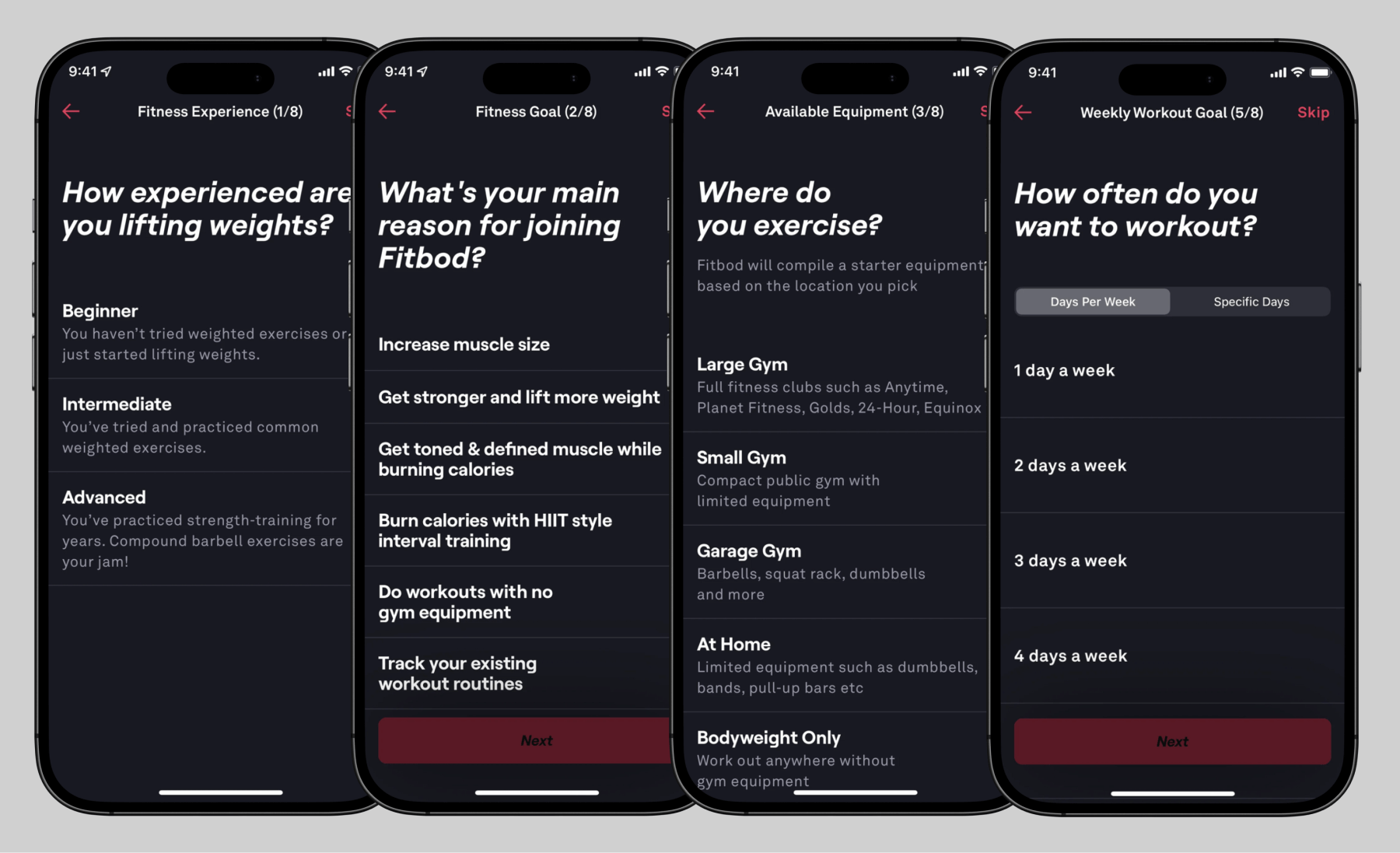
Bend is a wellness-focused app designed to make stretching an easy part of users’ routines. The app lets users choose between custom routines and pre-made sessions. Whichever route you choose, Bend makes sure that the routine is personalized to your goals and preferences, part of which you log during the onboarding process.
The app welcomes new users with a “Get started” screen that lets users proceed without creating an account. The app asks users about their stretching background, preferred workout time, health conditions, and other details to craft a truly personalized stretching experience right from the start.
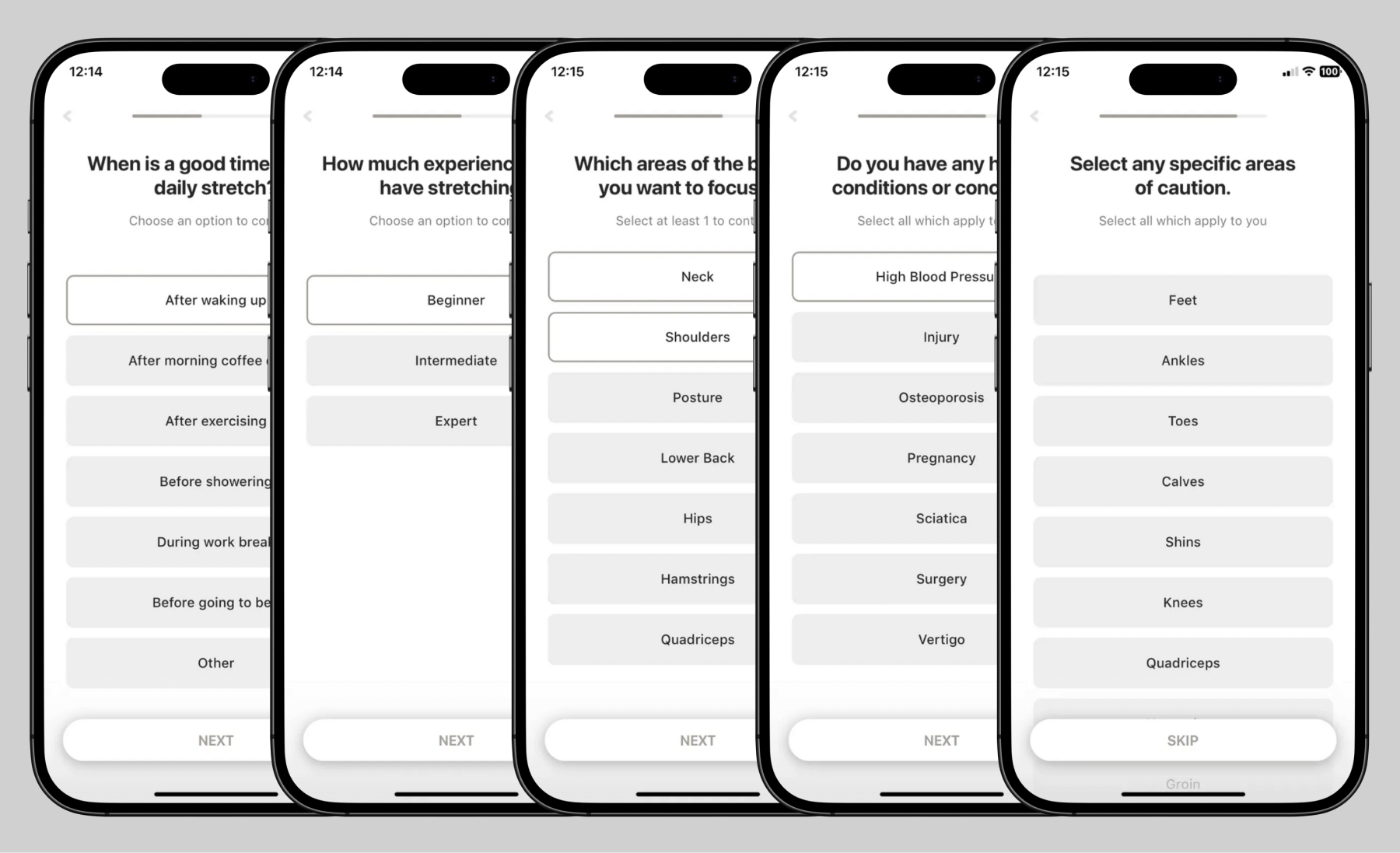
Notifications with behavioral triggers
Triggers that connect with users on an emotional and logical level are more likely to prompt action than those with a generic ‘Let’s do it’ appeal. Nudges with a high touch make users return to your app repeatedly and actively engage with it.
So, instead of one-size-fits-all notifications, opt for data-driven re-engagement, the one favored by fitness app market leaders:
- Send smart notifications based on user habits, such as reminders for missed workouts or encouraging progress updates.
- Use motivational messages ("You’re one workout away from hitting your weekly goal!") to re-engage users.
- Implement social and competitive triggers when friends have completed workouts or reached milestones.
- For inactive users, send gentle reminders if they skip a workout or don’t meet a daily step goal.
Keep in mind that however personalized your app notifications might be, they shouldn’t become overly intrusive or disruptive. Make sure to review user activity patterns to identify the right time and place to send the nudge.
Featured example
Asics Runkeeper is a GPS fitness-tracking app that keeps running fun and spirits high. Packed with guided workouts, personalized training plans, live tracking, and other goodies, Asics Runkeeper also keeps users in control by letting them toggle notifications for everything from workout reminders to community updates.
The app will send notifications letting users know when the new challenge begins, when their teammates reach certain distance milestones, or when it’s time to squeeze in a workout. Even with so many notification options, Asics Runkeeper manages to prevent notification overload by keeping users in control of all notifications, ensuring they only get updated on the things that interest them the most.
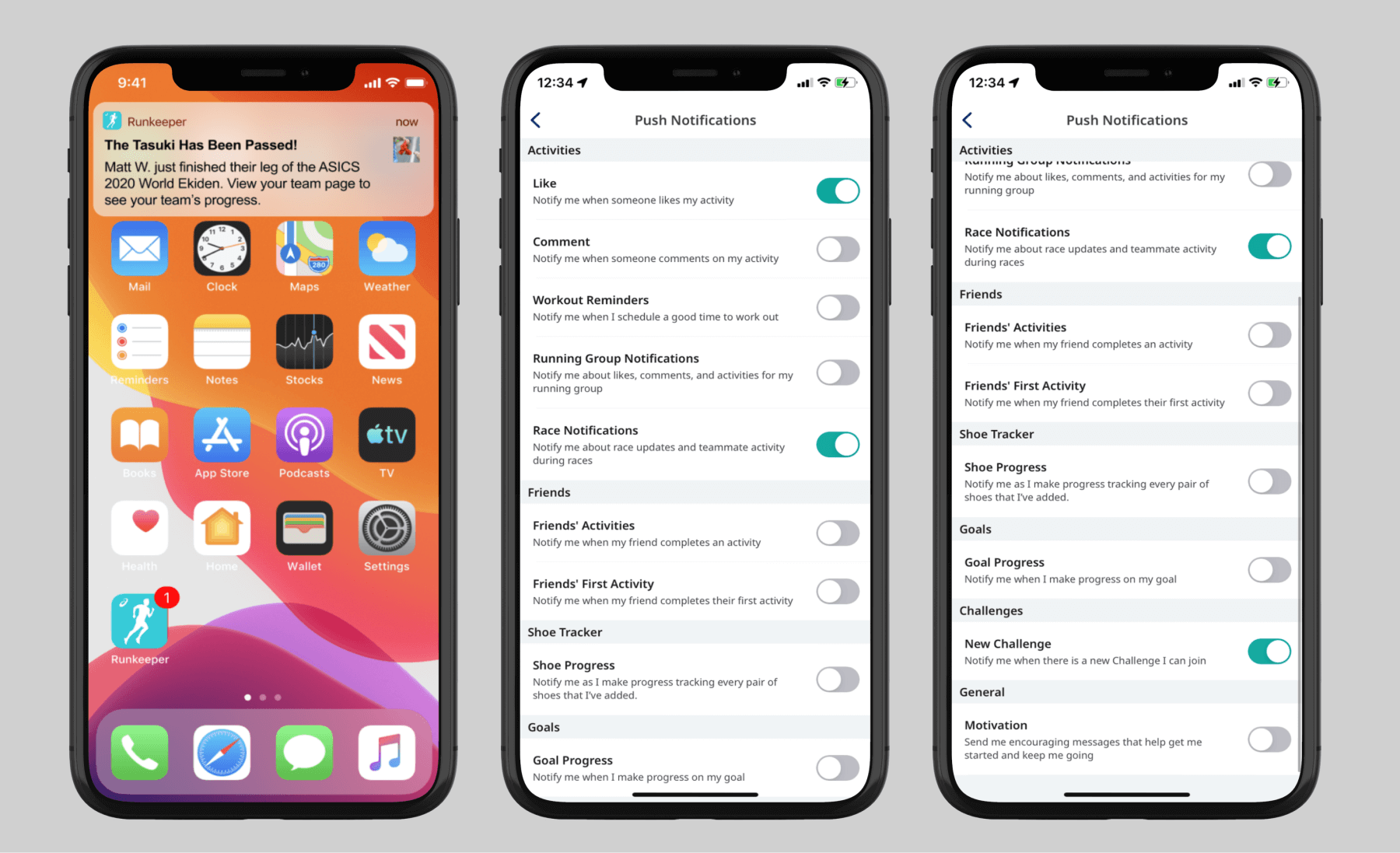
Content variety
These days, leading fitness apps shift from being task-specific solutions to becoming all-in, holistic platforms where users go to get tailored advice about nutrition, longevity, and mindfulness. Having everything in one place makes users linger in the app longer, which increases the engagement rates.
To turn your fitness app into a health and wellbeing club, cast your net wide to attract users with:
- Guided meditations, sleep tracking, and wellness tips
- Recipes, meal plans, and calorie calculators
- Personalized nutrition plans and advice from registered dietitians
- Partnerships with fitness influencers to create exclusive content
- Q&A sessions with experts and exclusive communities
You can also reinvigorate your relationships with users by offering them early access to new features before they're released to the public.
Featured examples
Aaptiv is a fitness app that introduces users to AI-fuelled, on-demand workouts and an established gym network. Among other things, Aaptiv’s secret habit-forming formula includes thousands of on-demand audio and video workouts across different categories — multiplied by fitness, mindfulness, and lifestyle tips. Fitness and health advice is personalized to every member and delivered by an AI-based SmartCoach that then helps users follow through on the tips.
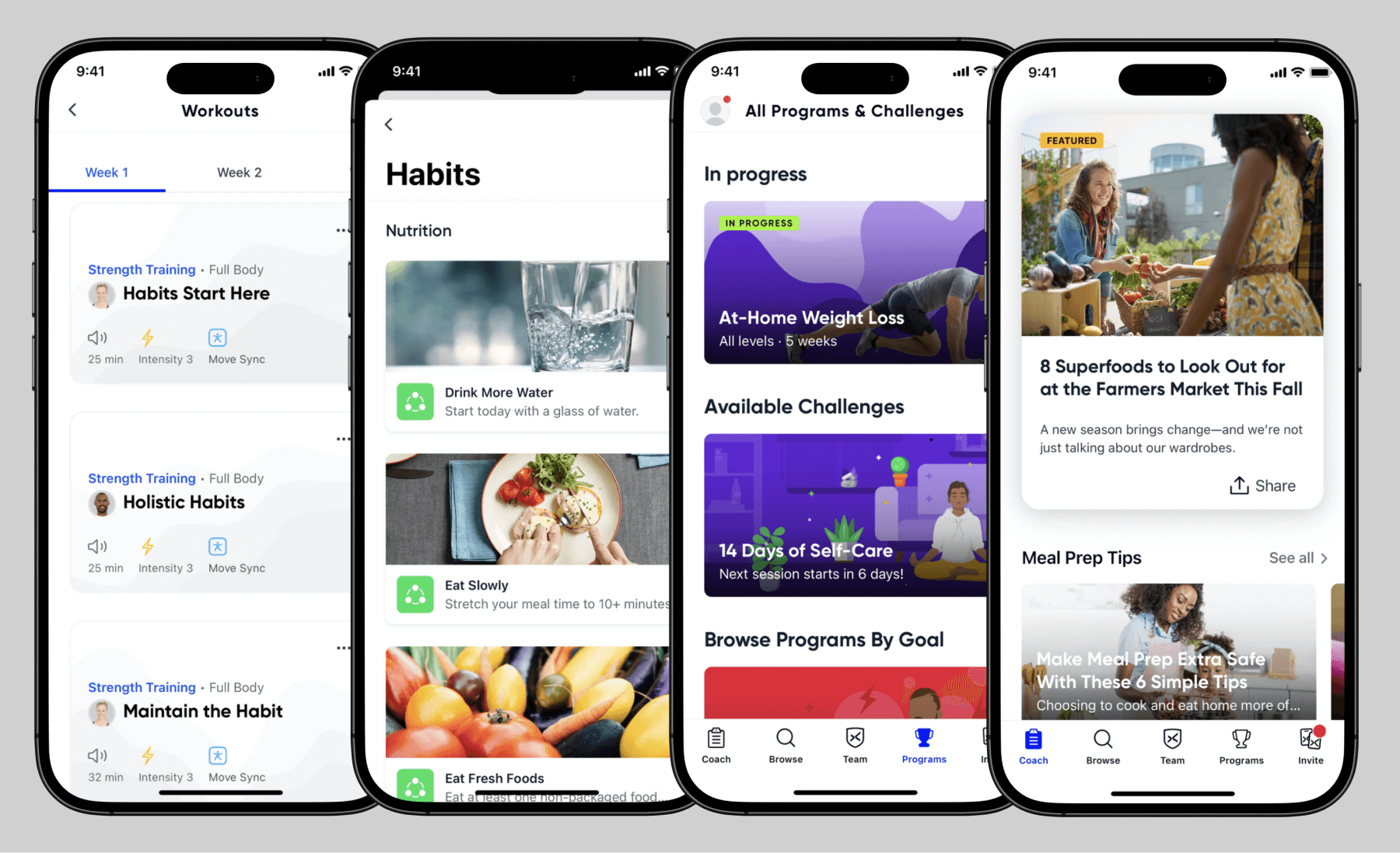
Fronted by Thor star Chris Hemsworth, the Centr app bundles everything one needs to get in shape without getting themselves into a fitness rut. Featuring around 1,000 workouts, 490+ recipes, 130+ mindfulness exercises, sleep visualizations, meditation sessions, and podcasts, the Centr app aspires to be a one-stop shop for health and fitness.
On top of this impressive body of fitness and wellness content, Centr members can also explore curated articles authored by Centr experts to get actionable tips on how to overcome everyday challenges.
To guide users through the vast library of content, Centr only offers content that’s relevant to users’ unique profiles and lets users filter the content according to their preferences.
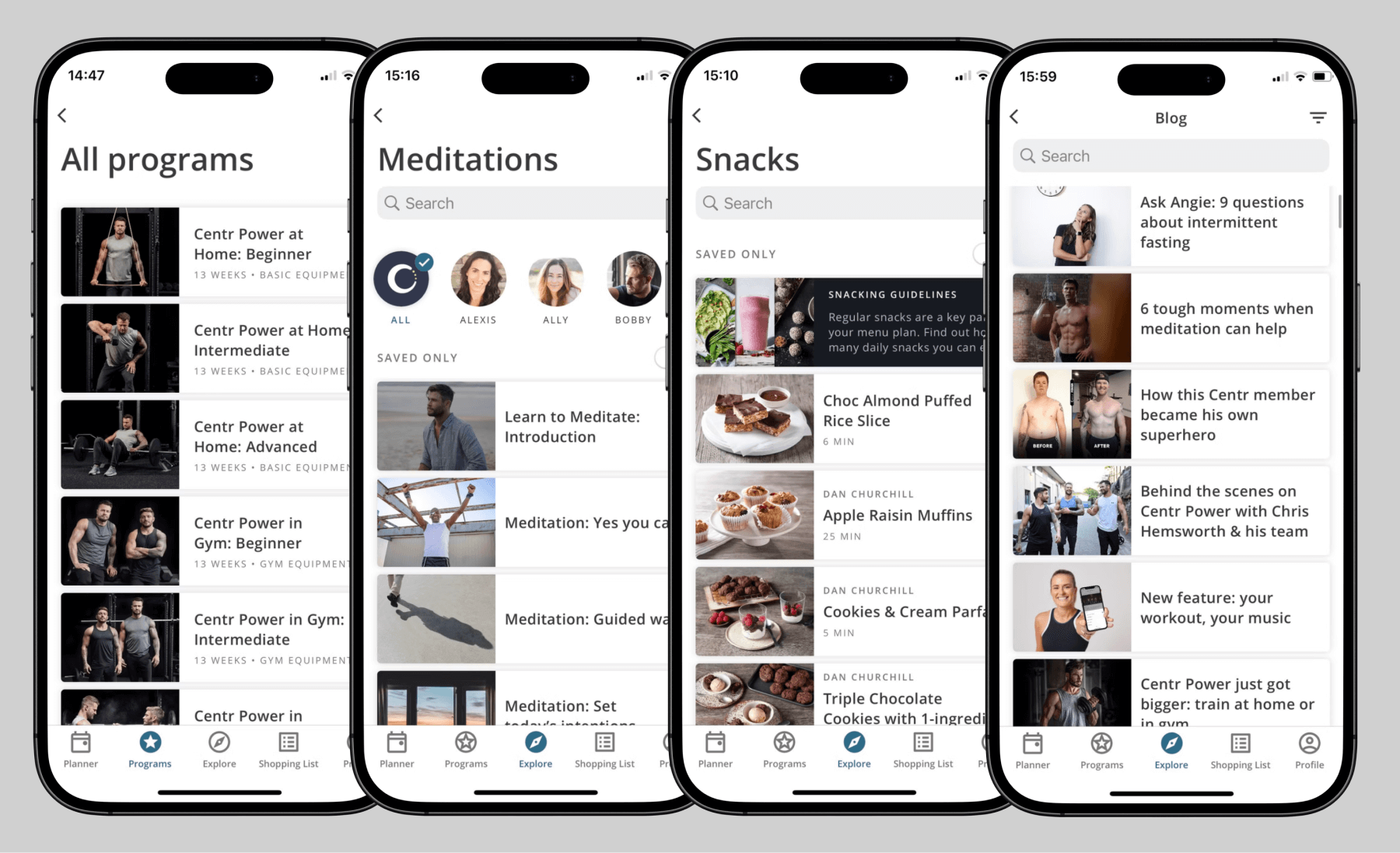
Virtual reality and augmented reality
Immersive technologies take gamification to the next level, allowing fitness app users to interact with your product in erstwhile impossible ways. VR devices capture users' full attention and expose them to gripping 3D worlds and virtual activities. AR-enabled fitness apps overlay digital elements onto the real world, enabling users to be present in both worlds.
Your workout app can use immersive technologies in different areas:
- Leverage AR to project virtual fitness trainers or workout instructions onto the user's actual environment.
- Immerse users in virtual fitness worlds where they can try different types of workouts that they might not have access to in the real world.
- Offer mixed reality workouts in the metaverse to transform fitness routines into engaging quests.
- Launch virtual gym memberships with avatar-based training.
- Supplement fitness rehabilitation training with AR and VR.
Augmenting your fitness app with AR and VR will also allow for more precise motion tracking, as those can track 3D movements in real time. Insights into joint angles, force, and power output will help your app provide nuanced recommendations on how users can improve their form and prevent injuries.
But keep in mind that for a truly immersive and hassle-free experience, your AR/VR devices must be lightweight and capable of tracking movement along six axes.
Featured examples
Touted as the ‘ultimate workout companion,’ SmartGym offers over 690 exercises with animation and instructions, plus over 130 pre-made curated workouts. In addition to standard body measurements, SmartGym allows users to capture their posture and shoulder angle to better analyze their body evolution.
Moreover, the app allows for real-time posture analysis — a feature that is equally beneficial for trainers and trainees. Personal trainers can take a photo with the AR overlay, mark the areas for improvement, and send the photo over to the trainees.
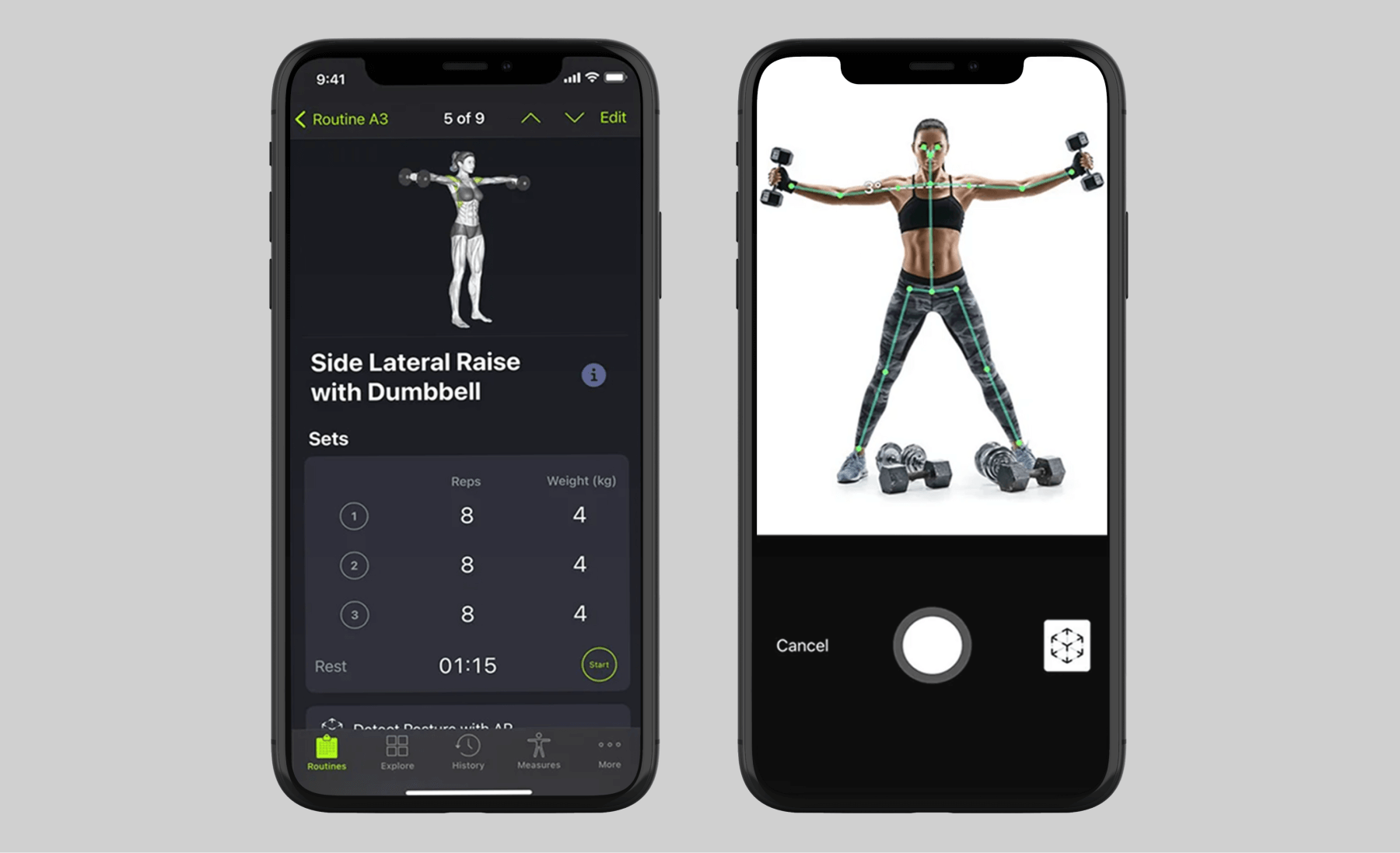
AR Runner is an augmented reality running game that overlays checkpoints onto real-world views, both indoors and outdoors. Users can complete personal challenges or compete against other players worldwide. This simple 40-mode gameplay turns running into a playful challenge, achievable for users of all ages and abilities.
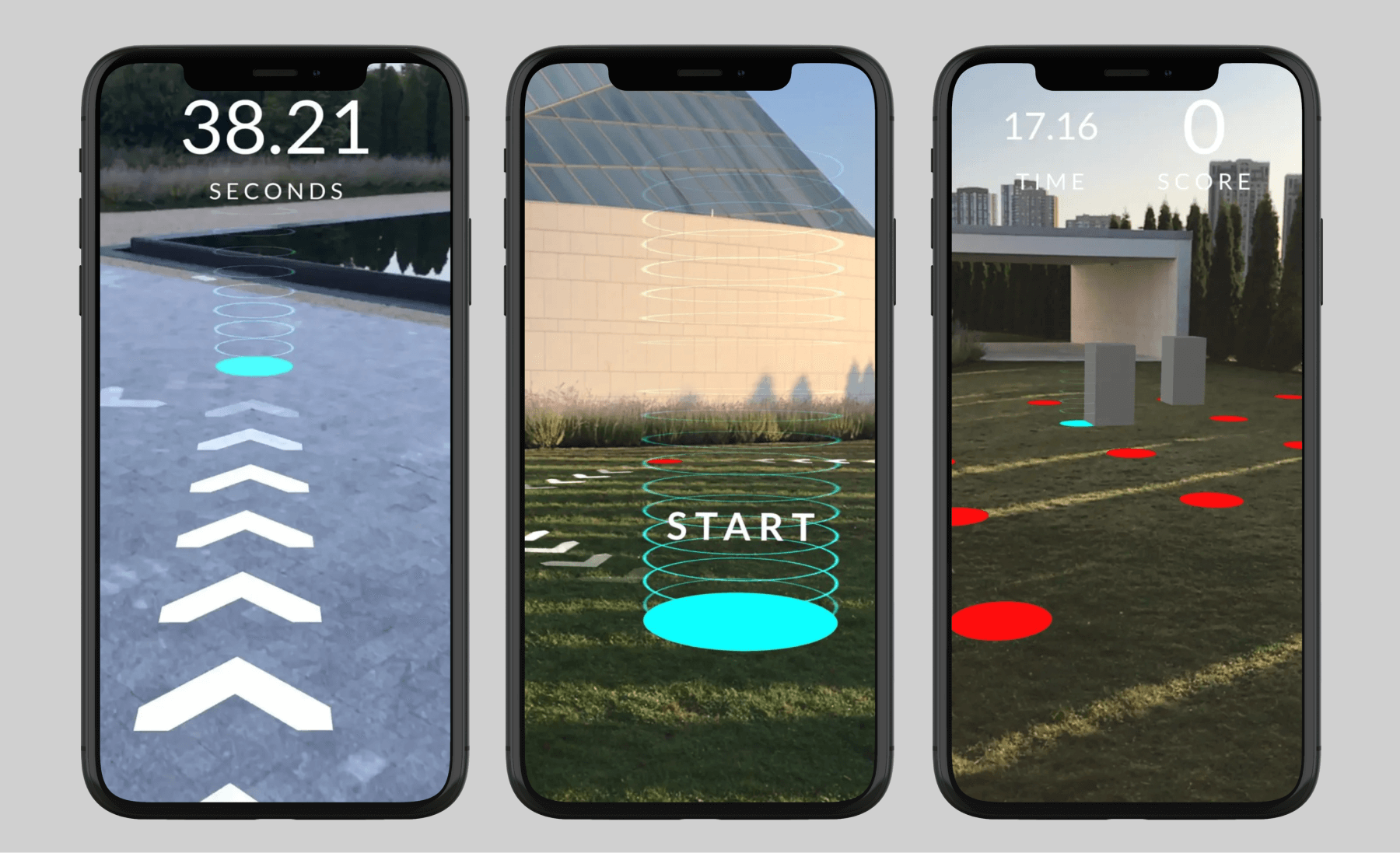
Incentive programs
According to research, users who accumulate a large number of rewards are usually considered to have a higher social standing within mobile fitness apps and have higher app satisfaction rates. So, the study's findings seem to spell good news for apps that sweeten the deal.
In fitness apps, incentive programs come in different flavors:
- Subscription incentives that offer discounted or free trials for premium features to deepen users’ relationship with your app.
- Milestone-based rewards that allow your users to unlock premium content after reaching specific goals.
- Real-world incentives that reward users for their achievements with branded merchandise, partner discounts, and other offers.
- Financial rewards that use cash payouts as an incentive towards users’ fitness and weight loss goals.
For some incentives, you can also offer a more hands-on experience, allowing users to choose between the rewards.
Featured example
Sweatcoin is a top-rated walking app that carved a niche in the market thanks to its get-paid-to-walk concept. The app turns steps into a digital currency called ‘sweatcoins’ that can later be redeemed for various rewards (e.g., goods or services), donated to charity, or exchanged with friends and family.
For many users, Sweatcoin increased their daily step count by 19% on average over the six months following registration.
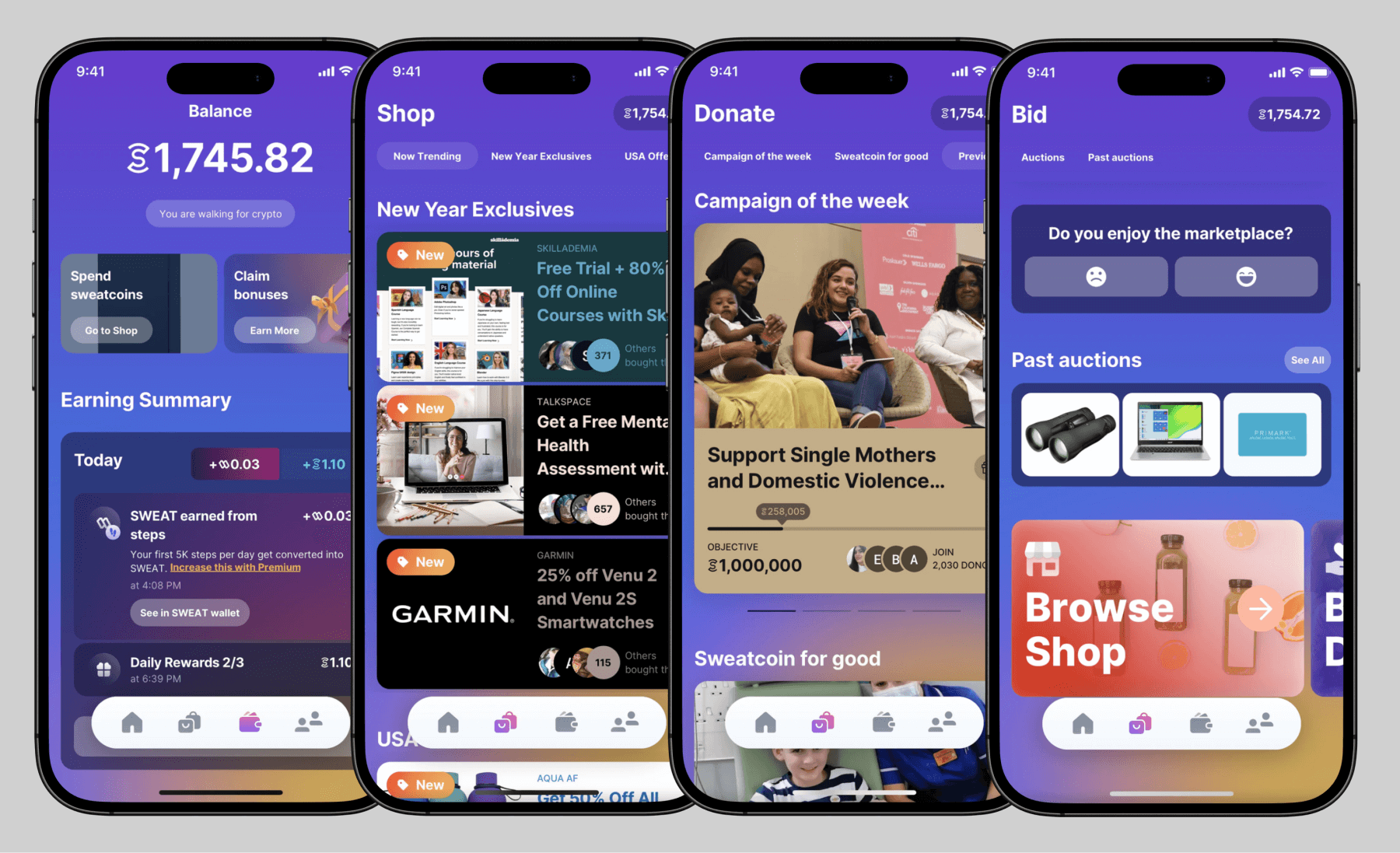
Continuous feedback loops
If you want to spot early signs of user dissatisfaction and timely address issues that dampen user enthusiasm, you have to keep your ears to the ground. An ongoing collection of user feedback, analysis, and prioritization of this feedback by your product development team will enable you to fix usability issues swiftly and add much-anticipated and high-value features.
Some users prefer to keep their suggestions to themselves, but you can prompt them to leave feedback by using in-app surveys and feedback buttons after workouts or milestones. Rewarding users with bonus points or premium content can also help keep that feedback engine running.
A variety of user support channels is another common thread among leading fitness apps. Customer support, community forums, and other dedicated spaces provide a platform for users to voice their suggestions.
Featured example
Designed specifically for progressive strength training, Ladder thrives on user feedback, drawing on user input to refine its suggestions, programs, and training experience. By soliciting user’s opinions on everything from their workout preferences to coach feedback, Ladder personalizes the app experience and maximizes its impact for each individual.
Not vibing with your coach? Ladder can offer a program led by another coach. Existing the workout midway? Ladder can adapt. The app always stays in tune with the user, putting them in the driver’s seat.
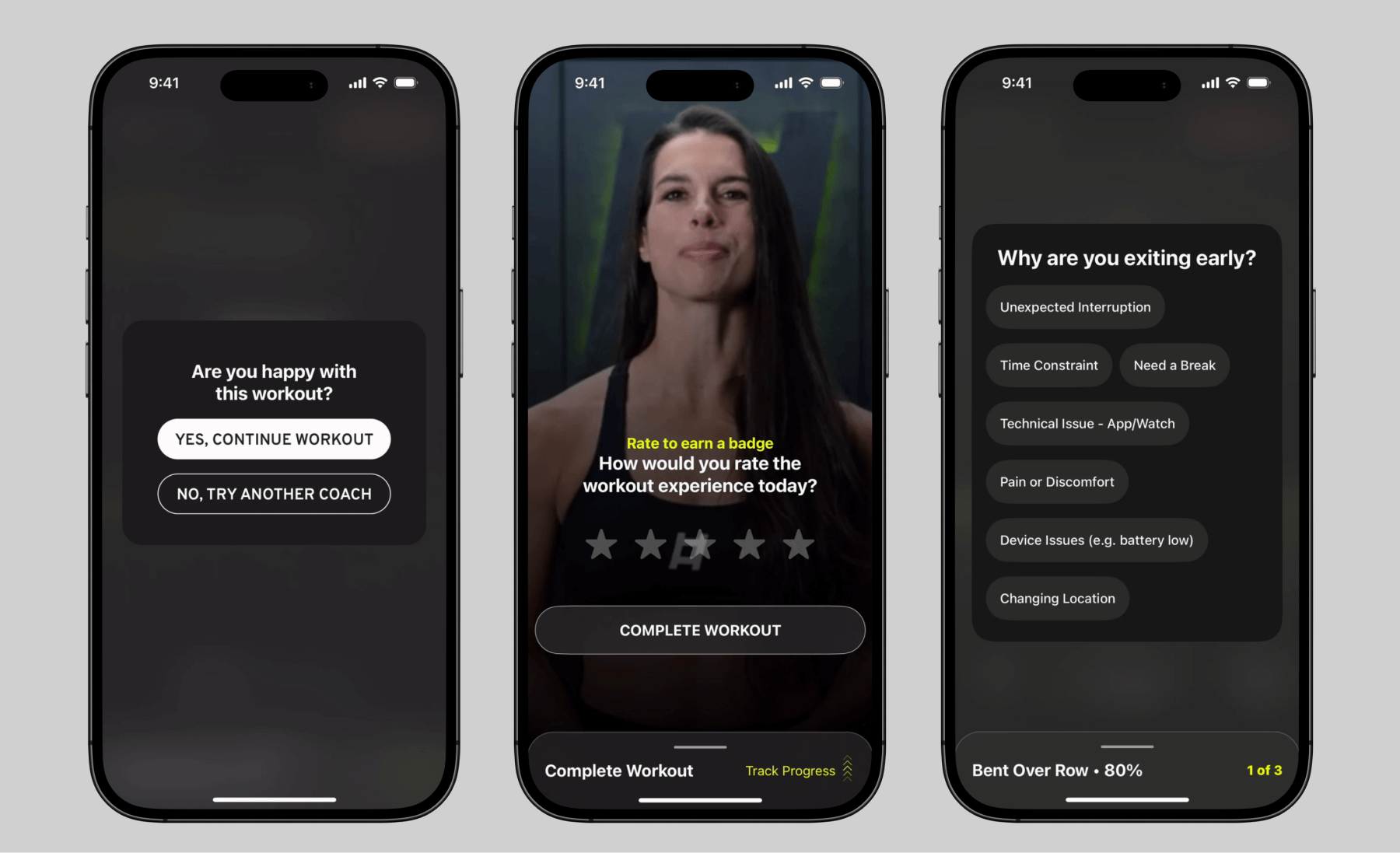
Seamless integration with wearable devices and other apps
If your fitness app requires users to manually input every breath, crunch, and calorie, users will likely abandon it for an app without the logging tedium. Automated data sync with fitness trackers, health apps, and other wellness solutions facilitates a comprehensive overview of the user’s health, allowing your app to personalize fitness routines to a tee and ease progress monitoring.
To achieve this level of comprehensiveness, enable syncing with other fitness and health apps, such as MyFitnessPal, Strava, Fitbit, or Apple Health. Facilitating smooth data sharing between the apps is challenging, so consider using linked open data approaches to promote a seamless and efficient user experience.
Along with third-party applications, you can encourage integrations with gym equipment for real-time training adjustments and immersive workout experiences.
Featured example
Adidas Running is a go-to running tracker app for over 170 million people who use it to log over 90 sports and activities. Central to the app’s mission is a vast integration ecosystem that includes 25+ apps and fitness devices, such as Zwift, Smashrun, Wahoo, and more.
The app’s integration strategy lets users keep track of a wide range of activities, consolidating their fitness data in one place. More importantly, this wealth of data allows the app to create and adjust running plans to match users’ fitness goals.
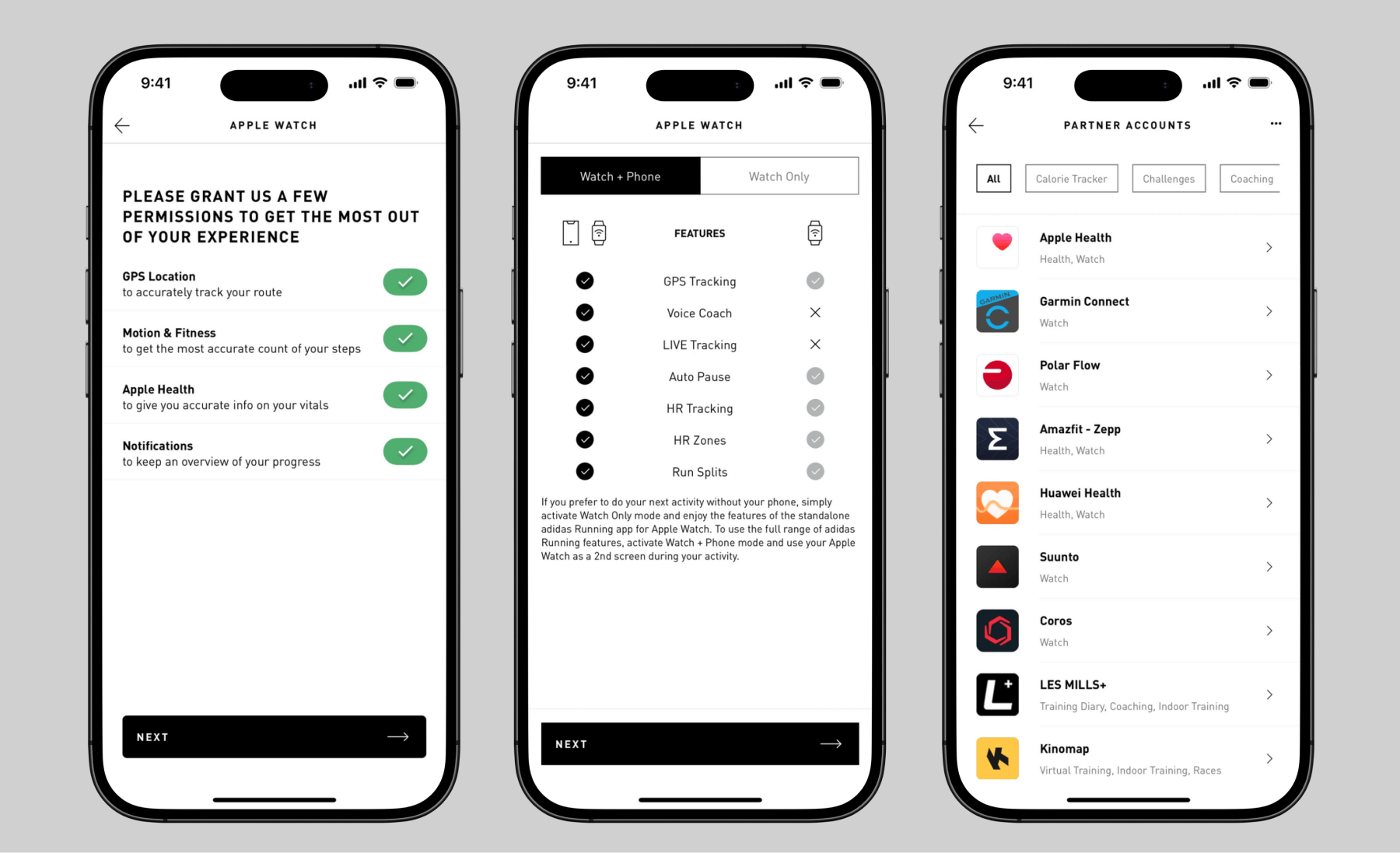
Advanced data analytics and user insights
The success of your mobile app retention strategies and re-engagement campaigns hinges on your understanding of the user base and your ability to leverage their data to inform your efforts. The deeper you gain insights into user behavior, preferences, and historical interactions, the more effectively you can engage users and serve them the right message at the right time.
Here’s what can help you get a tighter grasp on evolving user needs and inclinations:
- Predictive analytics — advanced predictive analytics is a must to assess potential churn risks and proactively offer tailored offers before at-risk users are fully lapsed.
- User behavior analytics — employ data analytics and machine learning to track and analyze in-app user behavior patterns, understand preferences, and identify areas for improvement in the app's design and features.
- Sentiment analysis — use this technology to analyze user feedback, reviews, and social media comments to understand how your app makes users feel.
Ensure that you have the necessary infrastructure and data governance strategy in place to analyze insights from various sources in real time and handle missing data points with minimal impact on your analysis.
Featured example
A manufacturer of wearable activity tracker technology, Fitbit is well known for delivering comprehensive insights to users regarding their health and movement. The device collects a wealth of health and fitness metrics, including steps, sleep patterns and stages, calories burned, distance traveled, and more. Not only does this data empower users to make more informed decisions about their health, but it also lays the foundation for Fitbit’s analytics.
Drawing upon user data, Fitbit tracks feature usage, measures user engagement, and pinpoints the areas of friction in the app's UX. The word has it: Fitbit also employs social listening to tap into its users’ minds and adjust its offers accordingly.
This year, Fitbit is likely to become the first fitness app to jump on the bandwagon of contextual and personalized user recommendations for sleep patterns and exercise routines. In 2025, Google is planning to equip the app with a personal health-based large language model that can successfully use physiological data for personal health tasks.
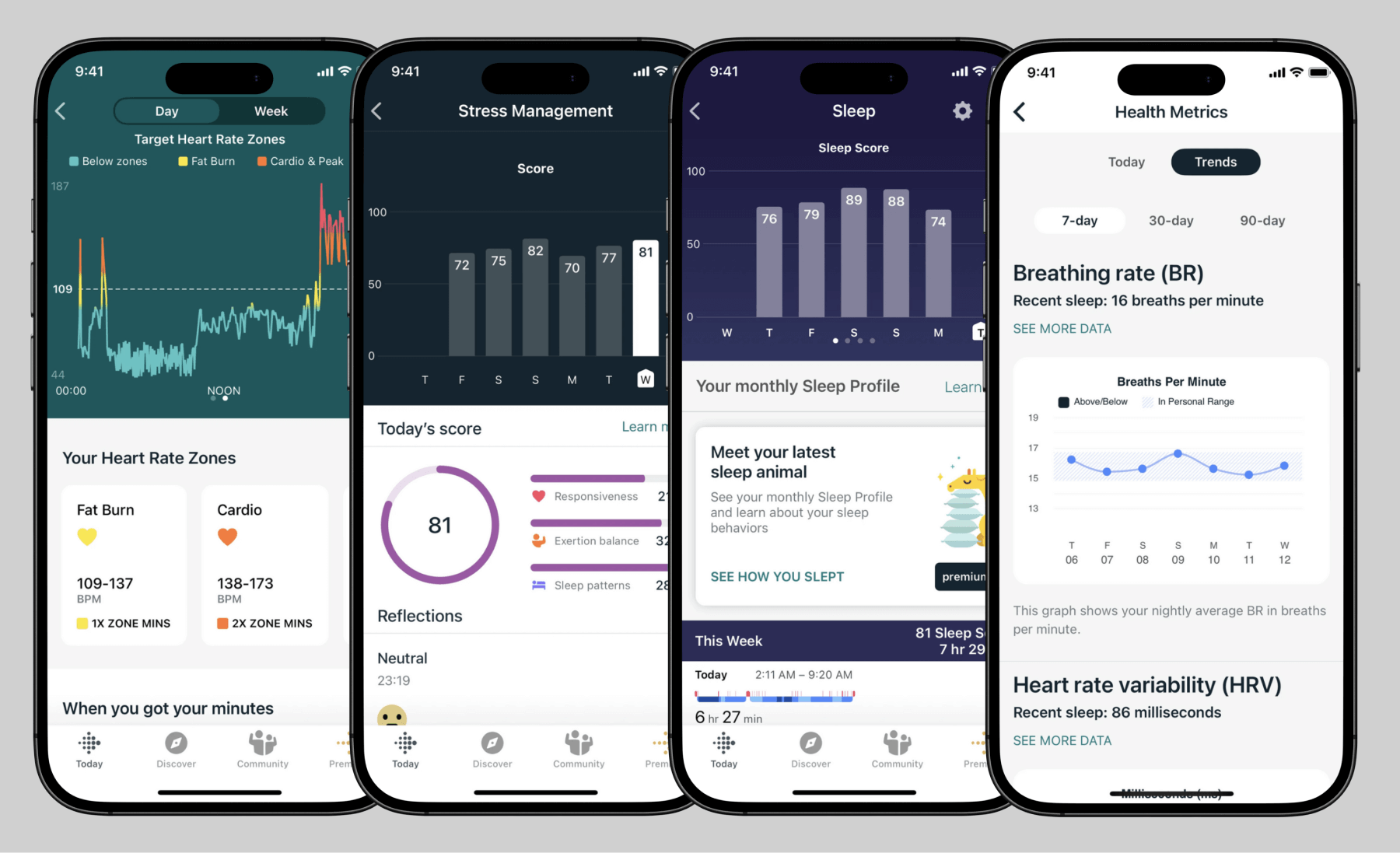
To sum up
Now, let’s summarize the findings and distill the best practices and underutilized features that can help your app improve user engagement and boost retention rates.
| Strategy | Best practices | Most often used in apps | Overlooked possibilities |
|---|---|---|---|
| Personalized user experience | Dynamic adaptability; context-aware personalization | Static, personalized feedback; tailored fitness content | Apps lack self-learning capabilities, real-time adaptability, and context-aware customization |
| Goal setting and feedback | Dynamically adjusting the set goal based on the user’s progress | Static goal setting by specificity, difficulty, and timing; action planning | Providing feedback on the achievability of the goal; goal re-evaluation |
| Habit-forming features | Using the hook model for maximum engagement | One or a few components of the hook model (trigger, action, reward, investment) | Quick and easy challenges with instant gratification; diversifying routines based on users’ real-time activity and Incorporating rest/inactivity into fitness routines |
| Gamification | Personalized, adaptive gamification; varying levels of challenges | Structural gamification tailored to users’ individual goals and progress | Combining structural gamification with content gamification; incorporating behavioral triggers; dynamic difficulty adjustment and adaptive rewards |
| Social features and community support | Strong community support; gamification of and rewards for social interactions | Content sharing, user profiles, in-app messaging, reactions, feeds, groups, comments, peer pressure | Adaptive, AI-powered social interactions; more profile customization features |
| Hyper-personalized onboarding process | Concise initial onboarding (up to 8 screens); progressive registration; fetching core user data to personalize experience moving forward | A combination of tutorials, guided walkthroughs, and a static onboarding process | Interactive walkthroughs; contextual guidance; adaptive onboarding process |
| Notifications with behavioral triggers | Context-based personalized reminders | Standard reminders that don't adapt to changes in a user's activity level or schedule | Social and competitive triggers, reminders for inactivity periods/missed workouts |
| Content variety | Varied workout formats; seasonal content; virtual coaches; content focused on all aspects of users’ well-being | Workout routines and plans, nutrition tips, exercise tutorials; user success stories; fitness hacks | Personalized content; community-generated content; educational content on adjacent topics (mental health, wellbeing, longevity) |
| Virtual reality and augmented reality | Ergonomic, lightweight design of devices; 6DoF tracking capability | Overlaying workout instructions on real-world environments | Accessibility of immersive experiences; immersive tech for rehabilitation; personalized, adaptive immersive experiences |
| Incentive programs | Combining intrinsic rewards (badges, achievements, etc.) with extrinsic rewards (discounts, merchandise, etc.) | Static, milestone-based intrinsic rewards | Customized incentives; progressive rewards |
| Continuous feedback loop | Using multiple ways to gather, prioritize, and act on user feedback | Support centers, user communities, app store feedback tracking, surveys | Conversational chatbots, post-workout feedback |
| Integration with wearables and other apps | Seamless integration with wearable fitness devices and other fitness and healthcare platforms | Integration with wearables | Integration with health apps/devices; integration with gym equipment; open data approaches |
| Advanced data analytics | Leveraging AI and machine learning to track data | Analysis of workout frequency and duration, nutrition, sleep, exercise, intensity, and geolocation | Mental health tracking |
Don’t break a sweat, break your retention ceiling
Want to spend less and earn more with your fitness app? Keep your users happy, engaged, and glued to your fitness application. Personalized experiences that adapt to your users’ needs in real-time, innovative workout delivery, and tailored gamification can encourage users to persevere with home workouts even when they don’t feel like it.
To fine-tune your retention campaigns and foster long-term relationships with users beyond the initial surge of excitement, make sure to implement comprehensive data collection, AI-enabled analytics, user feedback, and integration with various data points. Need a tech boost for your retention strategy? Orangesoft’s team has the tech muscle to flex your app's potential. Contact us to know how we can help you.
